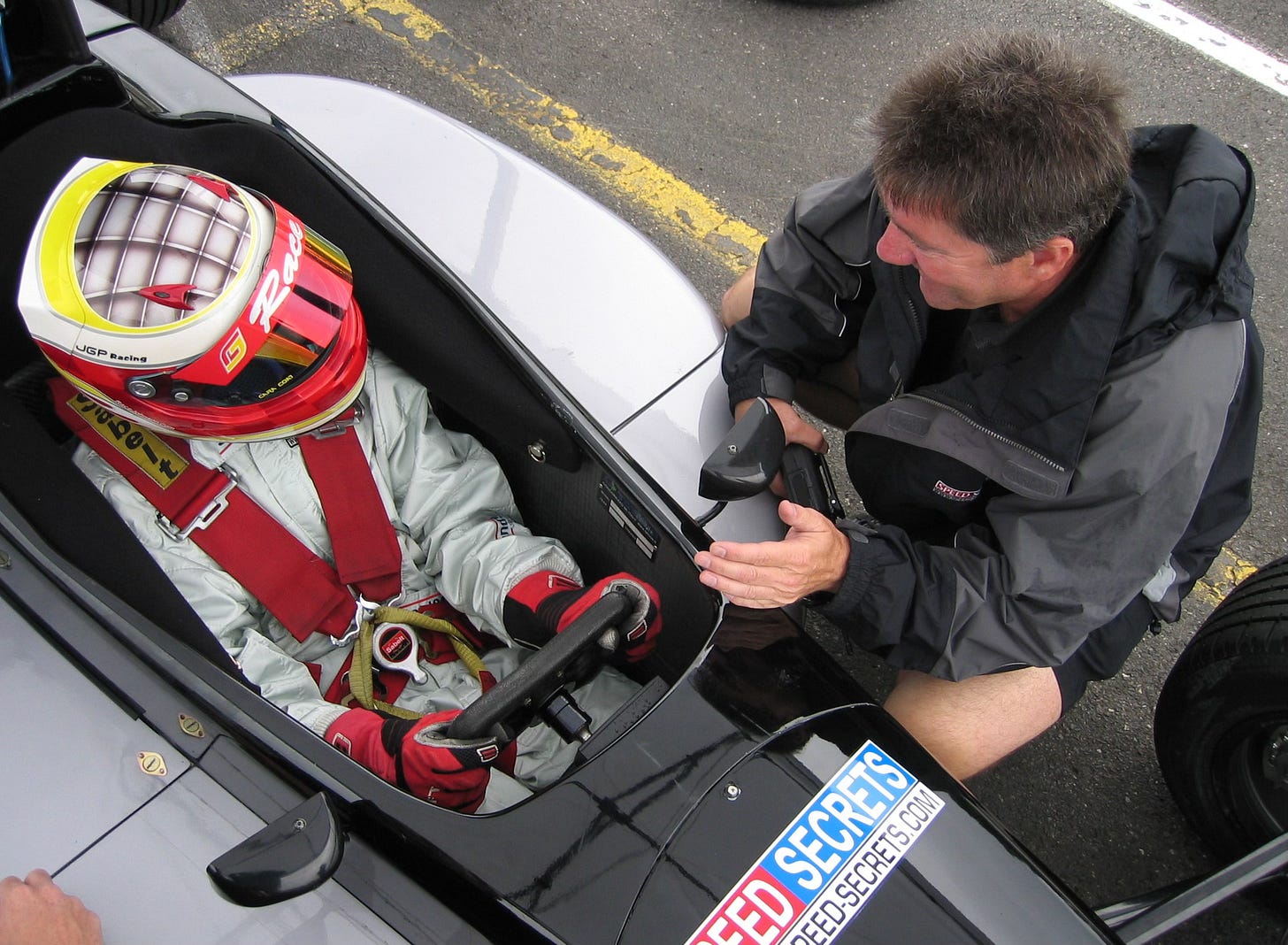Two of the most common questions that I’ve been asked through the years are:
Those may not be the exact words that drivers use, but they’re close. They’re at the core of what so many drivers are challenged by. And there’s almost always a touch of frustration in their voices when asking these questions.
How about you? Have you ever pondered those questions?
As a coach, this is pretty much my job description: figure out what a driver should focus on improving, and help them actually do that.
An advantage of being a coach is that I’m looking at what a driver needs from an outside perspective. One of the disadvantages of being a driver who wants to improve is that’s it’s difficult to be in the act of driving, while observing what you’re doing with your driving.
Over the years, I’ve discovered dozens of tactics that any driver, from novice track day driver to elite-level professional racer, will benefit from using. For simulator training alone, there are over twenty specific practices. It doesn’t really matter what their skills are like, whether they have a weakness in a technique or not, or what they or I think they should focus on to improve, these practice approaches, or “drills,” work.
When I mention the word “drills” to drivers, I sometimes see a confused look on their face. To many drivers, the idea of coaching is having someone tell them to brake later, turn in earlier, get on the gas sooner, look further ahead, and so on. But that’s like a basketball coach telling a player to “shoot the ball so it goes through the center of the hoop.”
Athletes in all sports—with the exception of motorsport—practice in a more effective way. As I’ve said many times, if football teams, for example, practiced like performance/race drivers, they’d show up to a practice session and play a game. But they don’t do that, do they?
Football teams practice drills—passing, kicking, running, catching, blocking, etc. The coaches break the game down into discrete skills, and have the players practice them over and over again. Then, they put a few of these skills together and combine them into another drill. And then, they play a practice game, a scrimmage. Finally, they play the game.
What do most performance and race drivers do? They drive around the track, over and over again, playing the whole game. Practicing a specific skill in the middle of playing the whole game is not the most efficient and effective way to improve.
Dr. Anders Ericsson (who passed away in 2020), considered by many to be the leading expert of understanding and studying how the best performers in any activity became the best, called this approach to learning and improving “deliberate practice.”
I really don’t know how or why I stumbled onto this approach with my own driving, and the instructing and coaching of other drivers. But at the time I called what I was doing— breaking the act of driving down into bite-sized techniques, and practicing just them—“strategic practice.” And it worked, so I kept doing that until one day I read some of Ericsson’s research and realized what I was doing was what he called deliberate practice.

This approach to learning, and the practice drills I use, are a bit of my coaching secret sauce (which is not all that secret since I share this stuff all the time). Some are used during an on-track session, some off-track, some on a simulator, and some with tools such as video and data. And it all starts with a solid understanding of how to practice.
According to Ericsson, these are the key characteristics of deliberate practice:
I want to touch on the point about deliberate practice being demanding. This may be one reason drivers don’t use this kind of practice enough: it’s not necessarily enjoyable. It might not even be fun—at least not as much fun as just turning laps. With the cost of every lap being what it is, most drivers would prefer to be having fun on each and every one of them. You have to be the right kind of person to find all of the deliberate practice enjoyable.
The second reason this approach to improvement isnʻt used as much as it should be is simply that we don’t have practice fields or courts. Football teams can stop and start on their fields. Tennis players can hit hundreds of serves. Golfers have driving ranges. Basketball players can practice just their free throws all day long.
Race tracks are not designed for us to stop and start, repeat just one corner over and over again, or slow down to practice just one specific driving technique.
Still, there are ways to integrate deliberate practice into whatever you’re doing on track. Even though deliberate practice involves feedback, you have the tools to do much of this yourself. Tools? Video, data, track map notes, simulators, and the process of self-debriefing.
I’m writing about all of this for two reasons:
As a driver who recently used some of these drills said in an email to me:
What the hell just happened? This driver broke the act of driving down into bite-sized chunks of techniques, practiced them, and then let them merge in his head on their own.
I’ve never actually seen this person drive, but based on a few things they said, I recommended a few drills for him to try. The rest was all on him. Interesting, eh?
